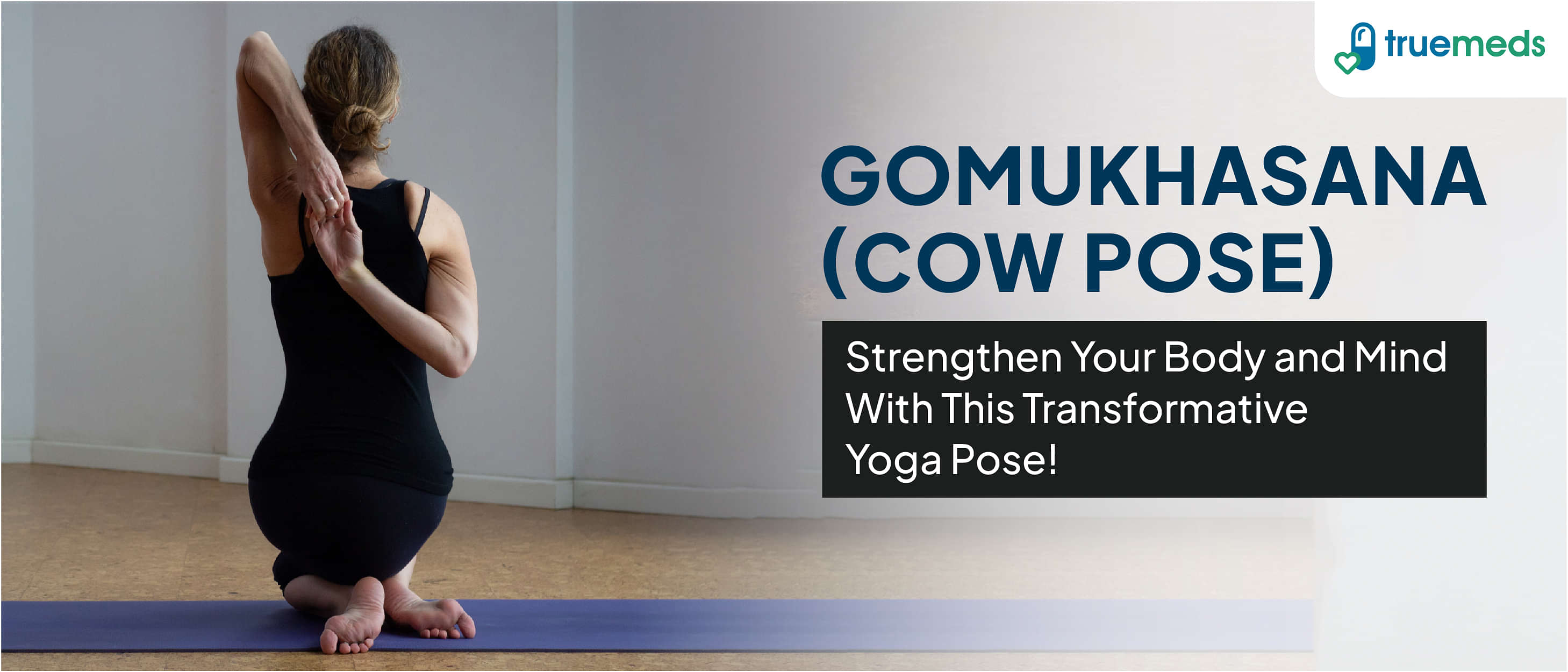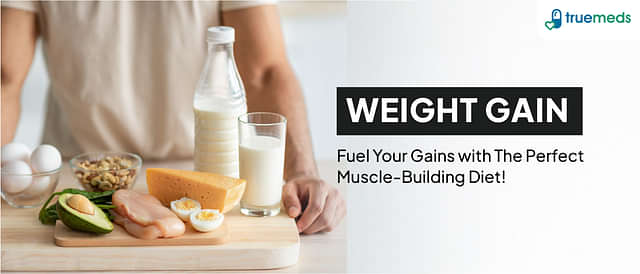Health Benefits of Gomukhasana: How to Do It and Precautions
Last updated on : 19 Nov, 2025
Read time : 7 min
Gomukhasana, or Cow Face Pose, is a seated yoga posture recognised for its deep, simultaneous stretch across multiple body areas. This pose actively engages the ankles, hips, thighs, shoulders, triceps, and chest. As part of a holistic yoga practice that enhances flexibility, concentration, and emotional balance, Gomukhasana serves as a valuable tool for reducing stress and improving mobility in today’s demanding lifestyle. Read on to learn about the steps, benefits, and safety precautions of this beneficial asana.
What is Gomukhasana (Cow Face Pose)?
Gomukhasana, meaning “Cow Face Pose” in Sanskrit (Gau = cow, Mukha = face, Asana = posture), is a seated yoga posture. The pose is named for the visual resemblance of the crossed legs and hands to the face of a cow, with the crossed legs suggesting the mouth and the raised arms representing the ears.
This pose primarily focuses on the shoulders, chest, hips, and thighs. It is known to release tension in tight muscles, enhance flexibility, and promote better posture. Gomukhasana may enhance mobility in the hips and is an effective chest and shoulder opener. It is particularly beneficial after long periods of sitting, helping to relieve built-up tension.
Top Health Benefits of Gomukhasana
Besides stretching and improving flexibility, Gomukhasana may offer the following benefits:
- Support for Sciatica and Back Pain – Gomukhasana may provide support for sciatica and general backache by gently stretching and releasing tension in the deep muscles of the lower back, hips, and buttocks (specifically the piriformis muscle) [1],[2]. By potentially improving flexibility in the spinal area, it may help reduce stiffness and discomfort associated with lower back tension [1]. Regular practice is thought to strengthen the muscles that support the spine, contributing to better stability.
- Tension and Stress Relief – Cow Face Pose is beneficial for relieving both physical and mental tension by providing a deep stretch to the shoulders, chest, and upper back. This release of muscle tension can promote physical and mental relaxation [3]. Practising Gomukhasana with mindful breathing may help reduce stress and anxiety by calming the mind and encouraging a sense of tranquillity.
- Posture Improvement – Gomukhasana helps to improve posture by stretching the often-tight chest and shoulder muscles and encouraging engagement of the upper back. It can help counteract the effect of ’rounded shoulders’ common in sedentary lifestyles [3]. By encouraging spinal alignment and strengthening the muscles that support an upright posture, regular practice promotes better body awareness.
- Enhances Spinal and Musculoskeletal Health – This pose improves flexibility in the shoulders, hips, and spine while relieving muscular tightness. It may enhance blood flow to the back and surrounding areas, which supports overall musculoskeletal health. Practising Gomukhasana regularly can contribute to long-term spinal health and injury prevention by maintaining mobility.
How to Do Gomukhasana (Step-by-Step Guide)
Follow this step-by-step guide to safely practise Gomukhasana:
- Warm Up – Prepare your hips, shoulders, and spine with light stretches like Cat-Cow Pose (Marjaryasana-Bitilasana), or gentle Sun Salutations to ensure the muscles are warm and pliable.
- Position the Legs – Begin in a seated position with legs extended. Bend your knees. Slide your left foot under your right thigh and towards your right hip. Cross your right leg over your left, aiming to stack your right knee directly above your left knee. Keep both sit bones grounded, if possible, and flex your feet actively to protect your ankles and knees.
- Align the Arms – Inhale and extend your right arm straight up. Exhale, bend the right elbow, and reach the right hand down your back. Extend your left arm out to the side, then behind your back, reaching upwards. Attempt to clasp your fingers behind your back or use a yoga strap to bridge the gap. Keep your shoulders relaxed and down away from your ears.
- Maintain Posture – Maintain a long, straight spine and a lifted chest. Engage your core gently. Focus on steady, deep, diaphragmatic breathing.
- Hold the Pose – Hold for 30 to 60 seconds, maintaining the stretch and mindful breathing.
- Release Safely – Slowly unwind your arms and then your legs, returning to a comfortable seated position.
- Repeat on Opposite Side – Cross the left leg over the right and mirror the arm positions (left arm up, right arm down) to ensure balanced flexibility and strength.
Safety Precautions and Risks of Gomukhasana
Gomukhasana requires mindful practice to maximize benefits and minimize risk of injury.
Safety Precautions
- Warm-up is Essential: Always begin with gentle warm-up poses to prepare the hips, shoulders, and knees for this deeper stretch.
- Prioritize Alignment: Focus on keeping the spine straight and the shoulders relaxed. Listen to your body, especially in the knees and hips; any sharp pain indicates you must ease out of the pose.
- Use Modifications: If you have tight hips or shoulders, use props such as a folded blanket or block under your hips to elevate them, or a strap to connect your hands behind your back.
- Gradual Progression: Avoid forcing your body into the full expression of the pose. Gradually work towards deeper variations as your flexibility naturally improves.
Contraindications
While generally safe, individuals with the following conditions or injuries should approach this pose with extreme caution or avoid it entirely:
- Severe Shoulder, Knee, or Hip Injuries: This includes tears, recent sprains, or chronic pain in these major joints. The pose places significant pressure on the knees and shoulders.
- Recent Surgery: Avoid if you have had recent surgery in the back, abdomen, hips, or shoulders.
- Limited Mobility: Those with severe stiffness or extremely limited joint mobility should work on preparatory poses first.
- Serious Abdominal Conditions: Individuals with a peptic ulcer, hernia, or an enlarged liver or spleen should generally avoid this pose or consult a physician first, as the deep hip compression may be contraindicated.
Takeaway
Gomukhasana is a therapeutic yoga posture that offers significant physical benefits, particularly for flexibility in the hips and shoulders, and for supporting better posture and reducing stress [3]. Its practice, when done correctly, may also offer supportive relief for conditions related to spinal tension, such as sciatica [1],[2].
Mindful practice, proper warm-up, and awareness of your body’s limitations are absolutely essential to avoid injury and maximize the pose’s benefits. Always start with modifications if needed and consult a healthcare professional or certified yoga therapist if you have any pre-existing health conditions before incorporating this pose into your routine.
Frequently Asked Questions (FAQs)
Which health conditions may benefit from Gomukhasana?
Gomukhasana may offer symptomatic relief for lower back pain and sciatica by stretching the surrounding muscles. It is also highly effective for improving posture and managing stress and anxiety.
Can we do Gomukhasana during periods?
Yes, Gomukhasana can typically be practised during menstruation to help reduce discomfort and promote relaxation. However, it is essential to listen to your body and avoid any strain or intense holding.
What is the physiology of Gomukhasana?
The pose is a deep hip opener and a significant shoulder stretch. Physiologically, it stretches major muscle groups including the gluteals and outer hips (hip rotators), deltoids, and triceps, while facilitating improved posture and potentially better respiration by opening the chest.
How long should I hold Gomukhasana?
You should hold Gomukhasana (Cow Face Pose) for 30 seconds to 1 minute on each side. Maintain steady, deep breathing and focus on relaxing into the stretch.
References
[1] Singh, M., & Kumari, M. (2019). Efficacy of yogasana in the management of Gridhrasi (sciatica). ResearchGate. https://www.researchgate.net/publication/331035235_EFFICACY_OF_YOGASANA_IN_THE_MANAGEMENT_OF_GRUDHRASI_SCIATICA
[2] Ravindra, P., Arora, M., & Sontakke, S. (2018). Evaluation of Gomukhasana and Shashankasana in the management of Gridhrasi with special reference to sciatica. World Journal of Pharmaceutical Research, 7(6), 957–966. https://wjpr.s3.ap-south-1.amazonaws.com/article_issue/1521165066.pdf
[3] Jadhav, P., & More, S. (2020). Efficacy of selected yogasanas on flexibility and balance in college-going students. International Journal of Physical Education, Sports and Health, 7(1), 16–19. http://www.kheljournal.com/archives/2020/vol7issue1/PartA/7-1-47-234.pdf
Disclaimer
Our healthcare experts have carefully reviewed and compiled the information presented here to ensure accuracy and trustworthiness. It is important to note that this information serves as a general overview of the topic and is for informational purposes only. It is not intended to diagnose, prevent, or cure any health problem. This page does not establish a doctor-patient relationship, nor does it replace the advice or consultation of a registered medical practitioner. We recommend seeking guidance from your registered medical practitioner for any questions or concerns regarding your medical condition.
Popular Articles
Recommended Articles
Recent Articles
Company
About UsHealth ArticleHealth StoriesHealth LibraryDiseases & Health ConditionsAyurvedaUnderstanding Generic MedicinesAll MedicinesAll BrandsNeed HelpFAQSecuritySubscribe
Registered Office Address
Grievance Officer
Download Truemeds
Contact Us
Our customer representative team is available 7 days a week from 9 am - 9 pm.
v4.10.1
2025 - Truemeds | All rights reserved. Our content is for informational purposes only. See additional information.
Our Payment Partners














































